Manatee Springs State Park
- February 14, 2024
- 0 comment
Discover Manatee Springs State Park’s Pristine waters, lush nature trails, and abundant wildlife. A perfect escape for nature enthusiasts. Located in the heart of Florida, Manatee Springs State Park is a natural wonder that beckons outdoor lovers and adventure seekers alike. With its pristine waters, lush nature trails, and abundant wildlife, the park offers a perfect escape for nature enthusiasts.
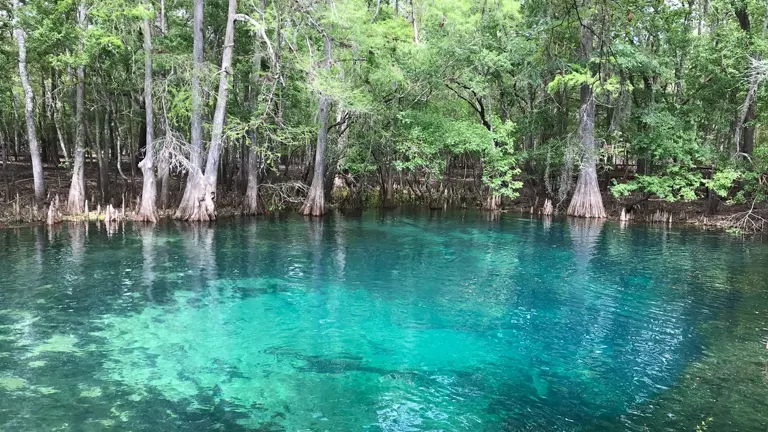
Whether you’re looking to dive into the clear spring waters, explore the scenic surroundings, or simply enjoy a peaceful retreat amidst nature, Manatee Springs State Park promises an unforgettable experience.
Characterizing Features of Manatee Springs State Park
- Pristine Spring Waters: At the heart of Manatee Springs State Park lies its crystal-clear spring, pumping an astounding 100 million gallons of fresh water daily. This natural spectacle provides a unique window into Florida’s vast aquifer system, offering visitors an unparalleled opportunity to connect with the natural world.
- Lush Nature Trails: The park is crisscrossed with numerous trails that meander through diverse habitats. These paths offer a peaceful retreat into nature, where the sounds of modern life are replaced by the rustling of leaves and the calls of the wild. Each trail offers its own unique view of the park’s beauty, from dense forests to scenic river overlooks.
- Abundant Wildlife: The park serves as a sanctuary for a wide range of wildlife, including the gentle manatees after which it is named. These majestic creatures can often be seen basking in the warm spring waters during the cooler months, providing a rare opportunity for visitors to observe them in their natural habitat.
History of Manatee Springs State Park
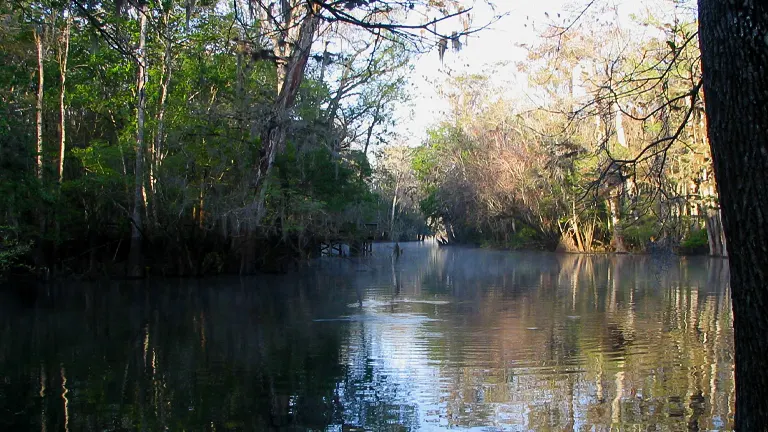
Manatee Springs State Park has a rich history that spans centuries. Originally inhabited by Native American tribes, the springs were a vital source of fresh water and a central part of the community’s daily life. In the 19th century, settlers were drawn to the area for its abundant resources and strategic location. Over the years, the park has seen various phases of development, from early tourism ventures to conservation efforts aimed at preserving its natural beauty. Today, it stands as a testament to the enduring appeal of Florida’s natural wonders and the importance of preserving such treasures for future generations.
Unique Ecosystem of Manatee Springs State Park
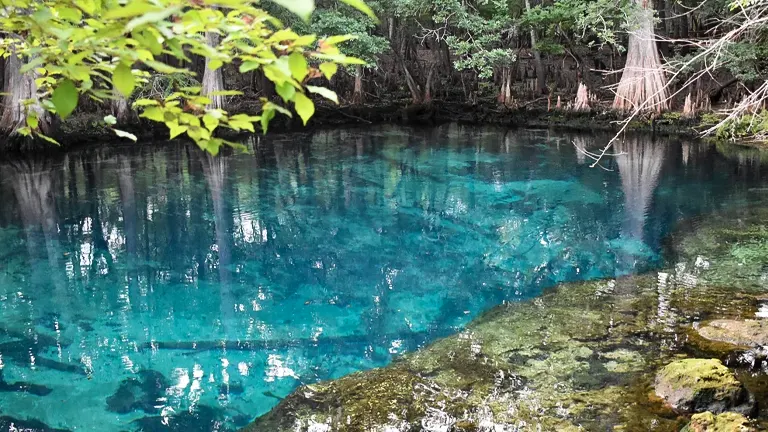
The ecosystem of Manatee Springs State Park is a vibrant tapestry of aquatic and terrestrial environments, each supporting a diverse array of life forms. The spring itself is part of a larger system of underwater caves and passages, which serve as a critical habitat for many species. Above ground, the surrounding forests and wetlands are alive with the sounds and movements of creatures that depend on this habitat. This unique ecosystem is a showcase of Florida’s natural heritage, highlighting the intricate connections between water and land, and the life that thrives at this intersection.
Location of Manatee Springs State Park
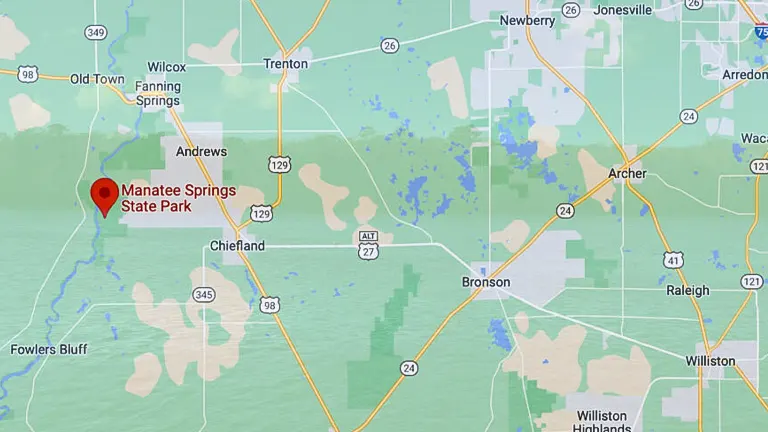
Manatee Springs State Park is located in Chiefland, Florida, where the serene Manatee Spring feeds into the famous Suwannee River. Known for its clear, 72-degree year-round spring waters, the park is a haven for nature lovers and outdoor enthusiasts. It’s situated in Levy County, approximately six miles west of Chiefland on State Route 320, offering visitors easy access to a diverse range of natural landscapes, from riverine systems to dense hardwood woodlands and wetlands, providing both an educational and recreational experience.
Here’s a specific guide on how to reach Manatee Springs State Park:
- From Gainesville, FL:
- Take FL-24 W/Archer Rd heading west out of Gainesville.
- After approximately 25 miles, merge onto FL-26 W/FL-24 W/NE State Rd 24/State Rd 24 W toward Trenton.
- Follow FL-24 W into the town of Bronson.
- In Bronson, turn left onto US-27 ALT N/US-98 N and continue for about 10 miles.
- Turn right onto FL-320 W/NW 115th St. Follow FL-320 W for 6 miles until you reach the entrance to Manatee Springs State Park.
- From Ocala, FL:
- Take US-27 N/NW Blitchton Rd north toward Williston.
- Continue to follow US-27 N for approximately 32 miles.
- In Williston, turn left onto FL-121 N/N Main St, continue to follow FL-121 N.
- Turn right onto FL-320 W/NW 115th St in Chiefland, and follow it straight to the park entrance.
- From Tampa, FL:
- Take I-275 N out of Tampa, and then merge onto I-75 N toward Ocala.
- Take exit 387 for FL-26 toward Newberry/Gainesville.
- Merge onto FL-26 W, then take a slight right to stay on FL-26 W.
- Follow the directions provided above from Gainesville, FL.
- From Tallahassee, FL:
- Take I-10 E from Tallahassee.
- Take exit 225 for US-19 S toward Monticello/Tampa.
- Continue on US-19 S, then take US-27 ALT S to NW 115th St in Chiefland.
- Turn left onto FL-320 W/NW 115th St, which will lead you to the park entrance.
- By Public Transportation:
- There is no direct public transportation to Manatee Springs State Park. The closest major bus and train stations are in Gainesville. From there, you would need to rent a car or take a taxi to complete the journey to the park.
Conservation and Recreation in Manatee Springs State Park
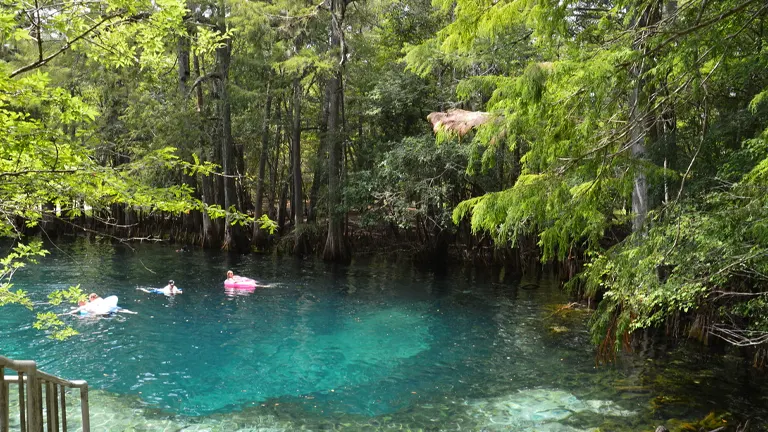
At Manatee Springs State Park, conservation and recreation go hand in hand. The park’s management practices are designed to protect its unique ecosystems while allowing people to enjoy and appreciate the natural beauty of the area. Efforts to conserve the park’s habitats ensure that future generations will be able to witness the majesty of the springs and the diversity of life they support. At the same time, recreational activities are carefully managed to minimize human impact, ensuring that the park remains a pristine sanctuary for wildlife and a place of wonder for visitors.
Diverse Vegetation and Plant Species in Manatee Springs State Park
- Longleaf Pine (Pinus palustris): Dominating the upland areas, the longleaf pine is a towering testament to the park’s diverse ecosystem. This species plays a crucial role in providing habitat for numerous birds and wildlife.
- Saw Palmetto (Serenoa repens): This ubiquitous shrub thrives under the canopy of longleaf pines, its presence indicative of the park’s well-preserved natural landscape.
- Cypress Trees (Taxodium): Bordering the spring and river, cypress trees with their distinctive knees (above-ground roots) create a dramatic aquatic landscape, offering refuge and nesting sites for various species.
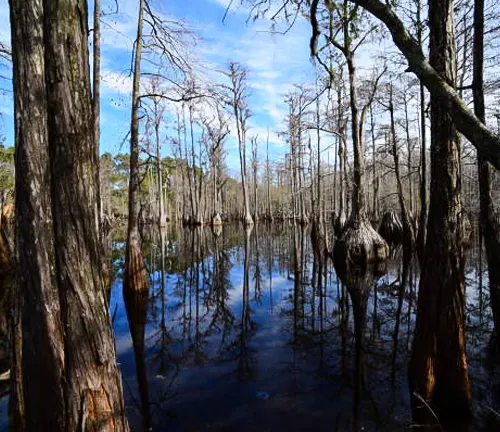
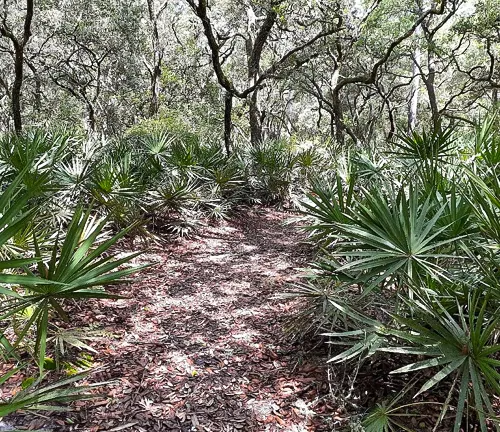
Fauna in Manatee Springs State Park
- West Indian Manatee (Trichechus manatus): The park’s namesake, these gentle giants seek the warm spring waters during cooler months, providing an extraordinary wildlife viewing experience.
- American Alligator (Alligator mississippiensis): An iconic symbol of Florida’s wild, alligators can often be spotted along the water’s edges, basking in the sun.
- Red-shouldered Hawk (Buteo lineatus): Soaring above, this raptor is a common sight, its distinctive call echoing through the park’s skies, highlighting the area’s rich avian diversity.
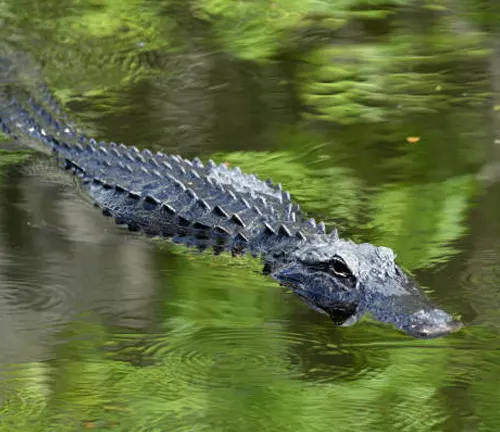
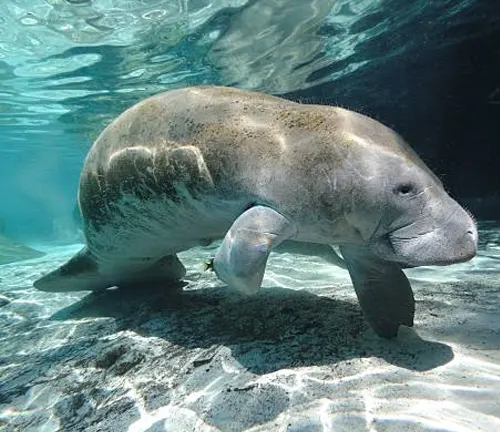
Attractions in Manatee Springs State Park
The Main Spring: As the centerpiece of the park, the main spring captivates visitors with its crystal-clear waters that maintain a constant 72°F (22°C) year-round. This natural spring is a first-magnitude spring, releasing millions of gallons of water daily into the Manatee Spring Run and eventually into the Suwannee River. It’s not only a stunning visual spectacle but also an important natural resource, supporting diverse aquatic life.
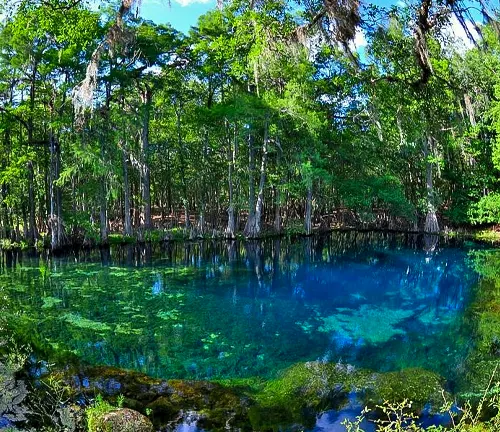
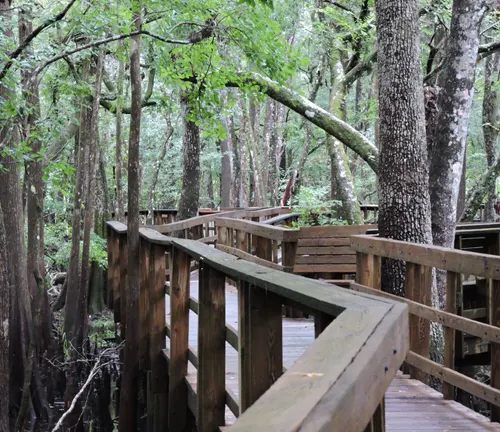
Boardwalk and Viewing Platforms: The park features an extensive boardwalk that winds through majestic cypress trees and lush vegetation, leading to viewing platforms overlooking the spring run. These structures offer unparalleled views of the spring and its inhabitants, providing a unique opportunity for visitors to immerse themselves in the natural beauty of the area without disturbing the ecosystem.
Catfish Hotel Sinkhole: Named for its historical use as a fishing spot, the Catfish Hotel is a large sinkhole near the spring run. It’s a fascinating geological feature that offers insights into the karst terrain prevalent in this part of Florida. The area around the sinkhole is rich in biodiversity and is a great spot for nature photography and bird watching.
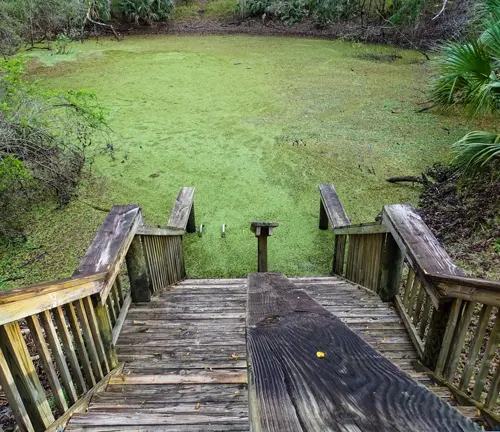

Blue Hole: The Blue Hole is a separate, deeper spring located within the park, offering a glimpse into the underwater cave system that feeds the springs. This area is particularly popular among certified cave divers seeking to explore the park’s underwater caves, showcasing the complex hydrology that sustains the springs and the surrounding ecosystems.
Wildlife Viewing Areas: The park is renowned for its wildlife, particularly the manatees that visit the spring run in colder months. Designated wildlife viewing areas give visitors a chance to observe these gentle giants, as well as other species like alligators, turtles, and a variety of birds, in their natural habitat. These areas are carefully managed to ensure minimal disturbance to the wildlife while providing educational experiences for visitors.

Recreational Activities in Manatee Springs State Park
- Snorkeling and Swimming: The crystal-clear waters of the spring offer a refreshing escape and a unique opportunity to observe underwater life up close.
- Canoeing and Kayaking: Paddling along the spring run or the adjacent Suwannee River provides a serene way to explore the aquatic landscape and spot wildlife along the banks.
- Hiking and Biking: With miles of trails winding through diverse habitats, visitors can choose their adventure on foot or by bike, experiencing the natural beauty of the park at their own pace.
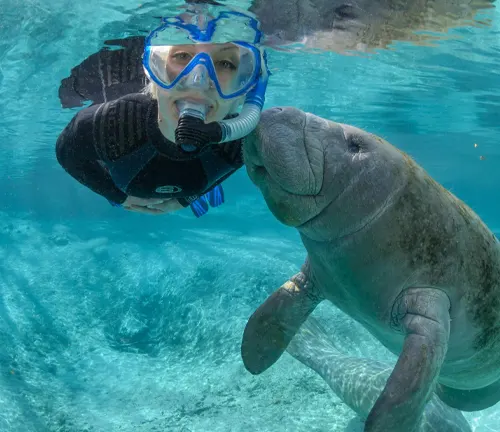
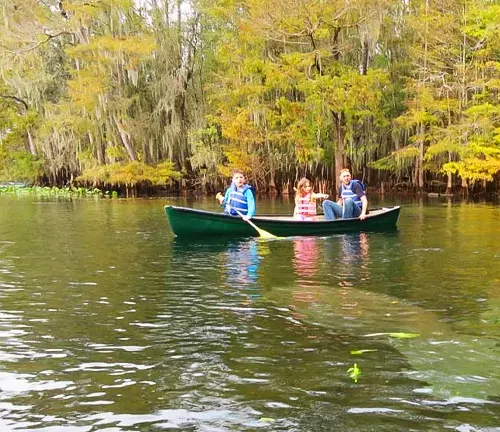
Different Facilities and Amenities in Manatee Springs State Park
- Visitor Center: The park’s visitor center is a hub of educational resources, providing guests with comprehensive information about the park’s history, wildlife, and ecosystems. It’s staffed by knowledgeable rangers who offer insights into the best ways to explore the park and its natural inhabitants. The center also features exhibits and displays that enrich the visitor experience with a deeper understanding of the area’s natural and cultural heritage.
- Picnic Areas: Scattered throughout the park are numerous picnic areas equipped with tables and grills, offering families and groups the perfect setting for outdoor meals amidst nature. These areas are strategically located to provide scenic views of the park, making them ideal spots for relaxation and socializing after exploring the trails or swimming in the spring.
- Campgrounds: For visitors looking to extend their stay, the park offers well-maintained campgrounds suitable for both tents and RVs. These camping facilities include electric hookups, water access, and nearby restrooms with shower facilities, allowing for a comfortable overnight experience in the heart of nature. The campgrounds provide a unique opportunity to experience the park under the stars and wake up to the sounds of the wild.
- Swimming Area: The designated swimming area in the spring run is a highlight for many visitors, offering a refreshing dip in the clear, constant temperature waters. Lifeguards are not provided, so visitors swim at their own risk, but the area is clearly marked for safety. It’s a family-friendly spot that becomes a focal point of activity, especially during the warmer months.
- Canoe and Kayak Launch: For those interested in exploring the waters further, the park features a canoe and kayak launch on the Suwannee River. This facility provides easy access for paddlers to embark on scenic journeys along the river, exploring the natural beauty of the area from a different perspective. Rentals are available, making it convenient for visitors to enjoy this activity even if they don’t have their own equipment.
- Nature Trails with Interpretive Signage: The nature trails throughout the park are enhanced with interpretive signage that educates visitors on the local flora, fauna, and geological features. These signs add depth to the hiking experience, allowing guests to learn about the ecosystem and its inhabitants as they explore. The trails vary in length and difficulty, catering to a wide range of interests and fitness levels.
- Restrooms and Shower Facilities: Strategically located near the main recreational areas, the park’s restrooms and shower facilities are accessible to visitors enjoying a day of swimming, hiking, or camping. These amenities are maintained to ensure cleanliness and comfort, enhancing the overall experience for guests spending time in the park.
- Parking Areas: Ample parking is provided near the park’s main attractions and facilities, ensuring easy access for visitors. The parking areas are designed to accommodate a high volume of vehicles, including spaces for RVs and trailers, making it convenient for all visitors to explore the park’s natural wonders.
Tips and Advice for Visiting Manatee Springs State Park
- Plan Your Visit According to Season: The experience at Manatee Springs State Park can vary greatly depending on the time of year. Visiting during the cooler months (November to March) offers the best chance to see manatees in the spring run. Summer months are ideal for swimming, snorkeling, and enjoying the water to cool off from the Florida heat.
- Bring Appropriate Gear: Depending on your planned activities, ensure you have the right gear. This includes water shoes for swimming, snorkeling equipment to explore underwater, and comfortable hiking shoes for the trails. Don’t forget a hat, sunglasses, and sunscreen for protection against the sun.
- Stay Hydrated and Prepared: Florida’s climate can be hot and humid, especially in summer. Carry plenty of water to stay hydrated throughout your visit. It’s also wise to bring snacks or a picnic, as dining options are limited within the park.
- Respect Wildlife: The park is home to diverse wildlife, including manatees, alligators, and various bird species. Always observe from a distance, do not feed or attempt to touch the animals, and follow guidelines to avoid disturbing their natural behaviors.
- Follow Leave No Trace Principles: Help preserve the beauty and integrity of Manatee Springs State Park by following Leave No Trace principles. This includes packing out all trash, staying on designated trails to protect the habitat, and not removing natural objects or artifacts.
- Check Park Conditions Before You Go: Before setting out, check the park’s official website or contact the visitor center for the latest information on conditions, any restrictions or closures, and special events that might affect your visit.
- Explore Beyond the Spring: While the spring is a major attraction, the park offers much more. Take time to explore the nature trails, the historic sites, and the scenic Suwannee River to fully appreciate the park’s diverse environments.
- Consider Camping for an Extended Experience: For a more immersive experience, consider staying overnight at the park’s campground. This allows you to experience the park at different times of the day, enjoy stargazing, and wake up to the sounds of nature.
- Be Prepared for Florida Weather: The weather can change quickly, so it’s wise to be prepared for rain, especially during the summer months. A lightweight, waterproof jacket or poncho can be invaluable during sudden showers.
- Capture Memories, But Stay Present: While capturing photos and videos is a great way to preserve memories, make sure to also take time to put the camera away and fully immerse yourself in the natural beauty and tranquility of the park.
Recommendation
Manatee Springs State Park is a must-visit for anyone looking to immerse themselves in the natural beauty of Florida. Whether you’re a wildlife enthusiast eager to spot manatees and diverse bird species, an adventure-seeker searching for the perfect kayaking or snorkeling spot, or simply someone who appreciates the tranquility of nature, this park has something for everyone. Its well-preserved ecosystems, rich history, and array of recreational activities make it an ideal destination for families, solo travelers, and photographers alike.
Conclusion
Manatee Springs State Park stands as a beacon of natural beauty and conservation, offering a sanctuary for both wildlife and people. It embodies the spirit of Florida’s untamed landscapes, serving as a reminder of the importance of preserving such places for future generations to enjoy. Visiting the park is not just an opportunity for recreation and relaxation, but also a chance to connect with nature and learn about the delicate balance of ecosystems. It is a place where memories are made, spirits are lifted, and a deeper appreciation for the natural world is cultivated.
FAQs
- What is the best time of year to see manatees at the park?
Manatees are most commonly seen during the cooler months from November to March when they seek the warm spring waters. - Are pets allowed in the park?
Yes, pets are allowed in designated areas but must be kept on a leash no longer than 6 feet at all times. - Can I rent kayaks or canoes at the park?
Yes, kayak and canoe rentals are available, offering a great way to explore the spring run and the Suwannee River. - Is there an entrance fee for the park?
Yes, there is a small entrance fee per vehicle, which goes towards the maintenance and conservation of the park. - Are there guided tours available?
While the park occasionally offers guided tours, particularly for educational purposes, visitors are encouraged to check the park’s official website for the most current offerings. - What should I do if I see wildlife?
Enjoy watching wildlife from a distance and do not attempt to feed or touch them. Disturbing wildlife is prohibited and can be harmful to both animals and humans. - Is swimming allowed in the spring?
Yes, swimming is allowed in designated areas of the spring, providing a refreshing and unique experience. - What facilities are available for visitors with disabilities?
The park offers accessible facilities including parking, restrooms, and picnic areas. The boardwalk and some trails are also designed to accommodate visitors with mobility challenges.
Manatee Springs State Park offers a tranquil retreat into nature’s embrace, where wildlife thrives and adventures await. It’s a place to reconnect, refresh, and marvel at the beauty of Florida’s natural landscape.

Benjamin Brooks
Forestry AuthorGreetings! I'm Benjamin Brooks, and my journey over the past 15 years has revolved around the fascinating realms of content creation, expertise in snow clearing, and the intricate world of lumberjacking and landscaping. What began as a simple curiosity about the natural world and heavy machinery has evolved into a passionate profession where my love for crafting words intertwines seamlessly with my lumberjacking and garden skills.


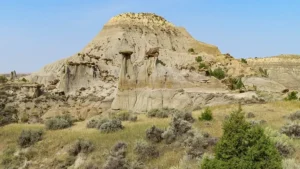

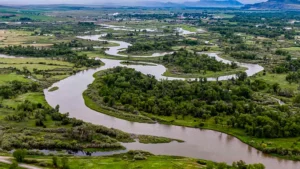
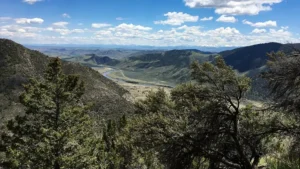


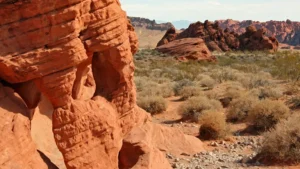

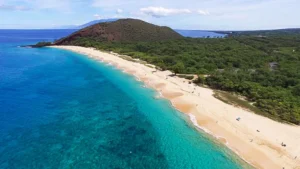
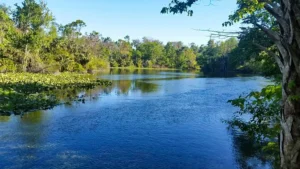
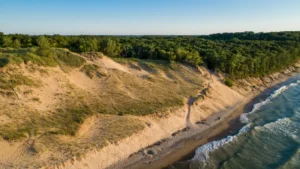
Leave your comment